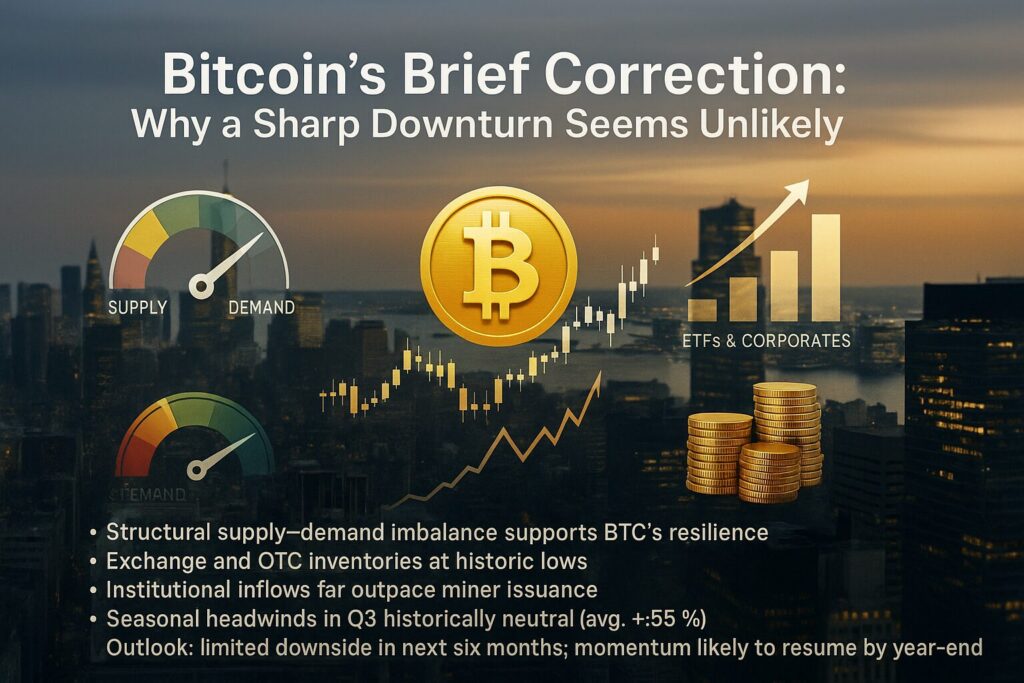
Main Points:
- Structural supply–demand imbalance supports BTC’s resilience
- Exchange and OTC inventories at historic lows
- Institutional inflows (ETFs & corporates) far outpace miner issuance
- Seasonal headwinds in Q3 historically neutral (avg. +0.55%)
- Macro risks: U.S. tariffs and Fed rate‑cut delays could trigger short dips
- Outlook: limited downside in next six months; momentum likely to resume by year‑end
1. Introduction
Over the past few weeks, Bitcoin (BTC) has shattered expectations by reaching new all‑time highs in the midst of what is traditionally the market’s weakest season. On July 14, 2025, BTC surged to $122,884—toppling its prior peak of $111,970 set just five days earlier—before retracing modestly to around $117,804 at the time of publication. This remarkable performance has prompted analysts to reassess the depth and duration of any correction.
Matt Mena, Research Strategist at 21Shares, argues that the confluence of robust fundamentals and constrained supply makes a deep, prolonged correction unlikely in the months ahead. In this article, we’ll unpack the key drivers behind this view, explore historical seasonal patterns, identify potential macro risks, and outline why downside appears limited over the next six months.
2. Structural Supply–Demand Imbalance
Exchange & OTC Supply at Record Lows
Data from leading crypto‑markets show that the combined Bitcoin balances held on exchanges and over‑the‑counter (OTC) desks are currently at all‑time lows. According to Mena, “the structural imbalance between surging demand and a rapidly vanishing supply base makes a prolonged correction increasingly unlikely”.
As fewer BTC sit idle on trading platforms, any sizable sell‑off would require significant pressure from existing holders. Yet, on‑chain metrics reveal that both retail and institutional participants are actively accumulating—even at the new highs—reducing the pool of readily available coins.
Institutional Demand Outpaces Miner Issuance
In the first half of 2025, U.S.‑listed spot Bitcoin ETFs alone have absorbed several multiples of the BTC that miners will mine this year. Corporate treasuries—while not always disclosed—are also quietly adding to their Bitcoin holdings in the background.
On July 15, U.S. spot BTC ETFs recorded net inflows of $404.85 million, underscoring the strong appetite among institutional allocators even as prices climb. When combined, ETF and corporate demand have created a one‑way bid that far outstrips new supply, further tightening the market.
3. Seasonal Context: The Third Quarter
Historical Q3 Performance
Bitcoin’s performance in the third quarter (July–September) has historically been mixed, with no clear directional bias. According to Coinglass data:
| Year | Q3 Return (%) |
|---|---|
| 2013 | +40.60 |
| 2014 | −39.54 |
| 2017 | +80.41 |
| 2019 | −22.86 |
| 2021 | +25.01 |
| 2023 | −11.54 |
Statistically, Bitcoin’s average Q3 return is +0.55%, and the median is −0.20%. These figures suggest that Q3 often acts as a consolidation phase rather than a decisive trend driver. In 2025, as of July 3, BTC had opened Q3 with a flattish −0.2% return, reflecting this historical neutrality.
Implications for 2025
Given the current structural tailwinds, even a mechanically neutral Q3 could translate into a modest gain, rather than the flat or negative outcomes seen in some past years. If seasonal indecision persists, BTC may trade sideways, allowing accumulation to continue before potentially resuming its uptrend in Q4.
4. Potential Macro Risks
Despite the strong fundamental backdrop, two primary macro risks could trigger short‑term pullbacks:
- U.S. Tariff Escalation
Unexpectedly harsh tariffs proposed by the U.S. administration could spook risk assets broadly. Mena cautions that if new levies on key trading partners exceed market expectations, equities, commodities, and cryptocurrencies—including BTC—might undergo a risk‑off repricing. - Delayed Fed Rate Cuts
Markets are pricing in rate cuts by the Federal Reserve later this year. Should Fed Chair Jerome Powell signal a dovish pivot later than anticipated, liquidity conditions could tighten, dampening speculative flows into Bitcoin and other risk instruments.
While both scenarios are plausible, Mena’s model indicates that neither risk is likely to precipitate a protracted downturn. Instead, any corrective phase would likely be relatively short‑lived as fundamental demand reasserts itself.
5. Recent Trends Beyond Fundamentals
Beyond the supply–demand dynamic, several emerging trends are reinforcing Bitcoin’s appeal:
- BRC‑20 & Ordinals Revival
The blossoming of BRC‑20 tokens and the resurgence of Ordinals have attracted fresh retail and developer interest, as on‑chain activity and fee revenue have ticked higher. - Layer‑2 Adoption
Growing usage of Lightning Network and Taproot‑based smart contracts is offloading smaller transactions from the base layer, improving BTC’s utility as both a settlement asset and medium of exchange. - Regulatory Clarity on Spot ETFs
The SEC’s approval of multiple U.S. spot Bitcoin ETFs this year has brought institutional comfort, as investors can now gain exposure through regulated vehicles, driving billions in additional inflows.
These complementary dynamics—while ancillary to the core supply crunch—help explain why BTC continues to set fresh highs even when broader crypto‑market sentiment (e.g., Google search interest) appears muted.
6. Outlook & Conclusion
Based on the confluence of factors—record‑low exchange inventories, outsized institutional demand, seasonal neutrality in Q3, and emerging on‑chain innovations—21Shares projects that Bitcoin is unlikely to experience a severe downturn over the next six months. In fact, they anticipate that liquidity returning in Q4 could reignite the bullish momentum, potentially carrying BTC to new highs by year‑end.
Investors should remain vigilant around the two macro‑risk events: U.S. tariff surprises and Fed rate‑cut timing. Yet, history suggests that such shocks tend to be absorbed relatively quickly in an environment where structural demand is so pronounced.
For those hunting new crypto‑assets, revenue streams, and real‑world blockchain use cases, Bitcoin’s resilience underpins a broader narrative: despite seasonal and macro headwinds, the world’s largest cryptocurrency continues to consolidate its role as a store of value and a core building block for the digital‑asset ecosystem.

